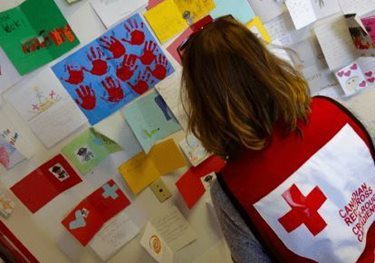Big or small, disasters impact the entire community. After a disaster hits, these impacts can be felt by many people in many ways. Beyond damaged buildings and infrastructure, disasters can put a lot of stress on families and communities. Family members can be separated for hours or even days. Access to support services like child care can be disrupted.

When an evacuation is ordered, families and individuals may have very short notice to make important decisions – what to bring, what to leave behind, when to go. People may live in shelters, without knowing if they will be able to return to the home they evacuated. This is not only stressful in the moment, the instability and uncertainty can also have more lasting impacts.
In the days that follow a disaster, families and individuals will learn the full extent of what happened and what has been lost. This only adds to the stress and sadness people will experience. Following a disaster, people of all ages may experience a variety of reactions or feelings that interfere with their ability to cope. These are expected, given the circumstances that people have endured. Children’s reactions to disasters and their aftermath are strongly influenced by how their parents, grandparents, families, teachers, and other caregivers cope during and after the events. They often turn to these adults for information, comfort, and help. children
There are some pretty common ways children and youth may react after a disaster or emergency, such as:
- Feelings of anxiety, fear, worrying about their own safety and the safety of others (including pets and wildlife)
- Children may be especially afraid of becoming separated from their family, and young children may become more clingy
- Fear of another disaster, or a new one starting
- Behavioural changes, such as increased or decreased activity level, increased irritability, aggression and angry outbursts, withdrawal
- Physical complaints, like headaches and stomach aches
- Changes in sleep patterns and appetite
- Lack of interest in usual activities, like playing with friends
- Regressive behaviours
- Adolescents may show increased high-risk behaviours like drinking or substance abuse
So how can parents and caregivers help?
- Spend time talking with your children, answer their questions honestly, ask their ideas and opinions - and let them know it’s okay for them to share their questions or express their fears and concerns
- For younger children, try to follow conversations about the disaster with a favourite family story or activity to help them feel safe and calm
- Remember that children who are clinging need to be reassured – leave them when you must, but reassure them you will be back
- Create an environment where children feel safe enough to ask questions, or share how they are feeling
- Remember that teenagers can often behave like they are unaffected or concerned by things like disasters. They still need the adults in their lives to pay attention to their feelings and reactions
- It’s very important to remember to also take care of yourself. Children will look to the adults around them for how they should be reacting and responding. Adults should remind themselves that they have also experienced something traumatic, and need time to think, grieve, and plan.
Children and youth are amazingly flexible and resilient, and parents and caregivers are capable of helping their children overcome their fears and feelings of anxiety about stressful events. However, getting additional help is a good idea if a child continues to show significant changes in his or her behaviour. Consider seeing a doctor or healthcare professional if you are worried about yourself or someone in your care.
For more information, read
this guide to disaster recovery for parents and caregivers.